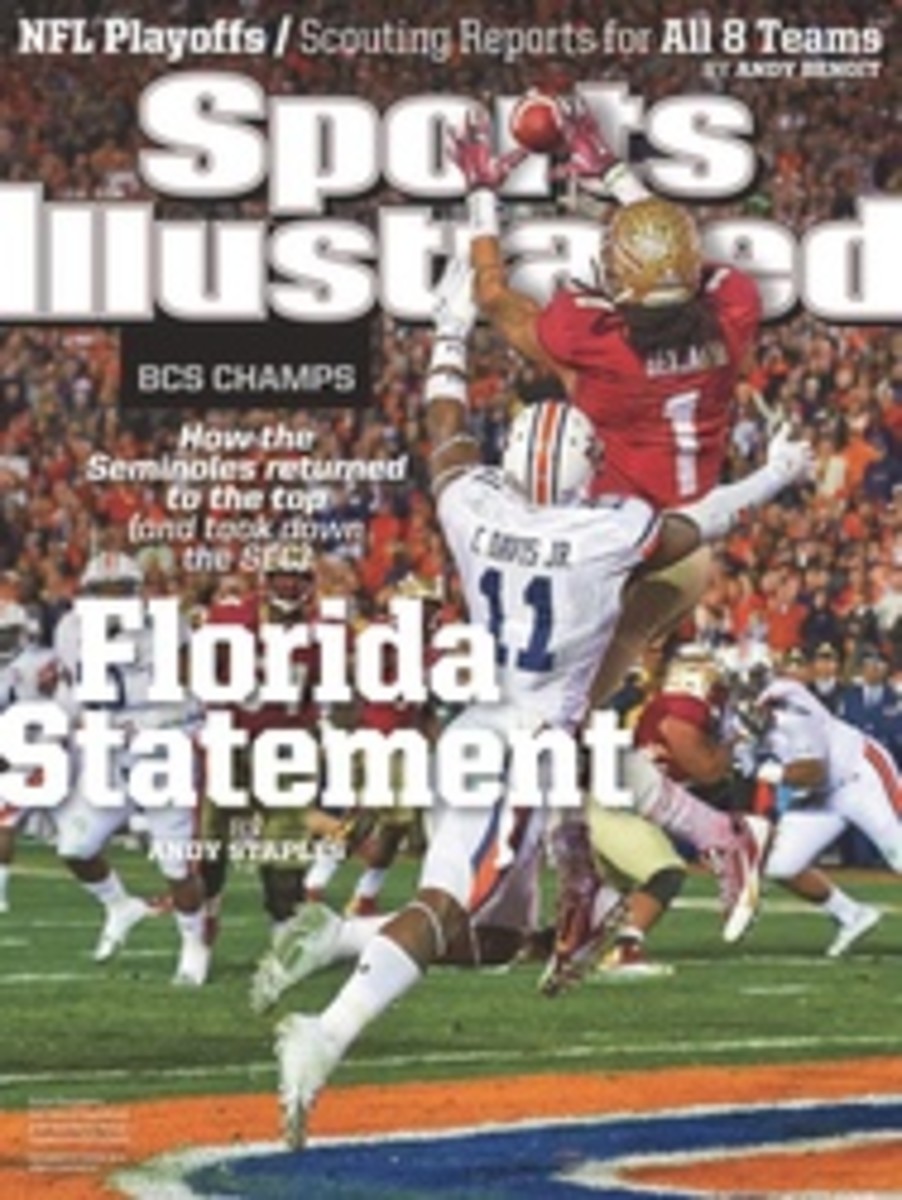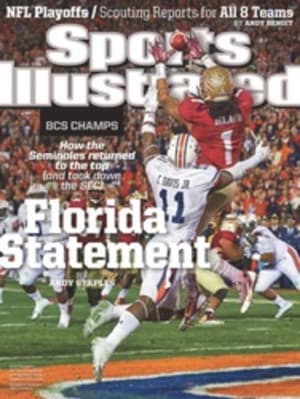
THE COLD HARD TRUTH
THE TOPIC of extreme weather can elicit a chilly response from even the most temperate of quarterbacks. "Whoever wrote that narrative can shove it where the sun don't shine," the Broncos' Peyton Manning said last month of the idea that he struggles in the cold—though his career record, in subfreezing games, is just 4--7. Joe Flacco of the Ravens got even frostier when he was asked ahead of last year's Super Bowl about this season's, which will be played on Feb. 2 at MetLife Stadium in East Rutherford, N.J. "I think it's retarded," Flacco said. "I probably shouldn't say that. I think it's stupid."
Stupid or not, the game—the first Super Bowl in an open-air venue in a cold-weather city—is just four weeks away, a reward for the construction of the Giants' and the Jets' newish, rather soulless $1.6 billion facility. And so it is time to focus on exactly how the elements might affect the 48th edition of America's most popular annual sporting event. STATS Inc. has released a study, commissioned by MetLife, that seeks to examine the havoc that the cold wreaks on NFL games. Its conclusion: There isn't much. The study found that since 1991, the league's teams have combined to average 42.5 points in temperatures 70° and above, and 41.0 points in those below 40°. Other stats are similarly close: 1.90 turnovers versus 1.81; an 81.6 passer rating versus 76.5; a 66.8% field goal rate versus 58.1%.
Still, 40° isn't particularly frigid—the study, remember, was commissioned by MetLife, which has a substantial horse in the race—and the meteorologically inclined believe the league would be lucky should this Feb. 2 turn out to be so balmy. In August the Farmers' Almanac, which claims an accuracy rate of more than 80% since it began publication in 1818, predicted, "Over the Northeast and Mid-Atlantic states, we are 'red-flagging' the first 10 days of February for possible heavy winter weather. But even if we are off by a day or two with the timing of copious wind, rain and snow, we wish to stress that this particular part of the winter season will be particularly volatile and especially turbulent."
"Put simply, the NFL is really rattling the meteorological tiger's cage," says The Weather Channel's Jonathan Erdman. The average high for Feb. 2 in nearby Newark, according to Erdman, is 40°; by 6:30 p.m., the time of the kickoff, temperatures are nearer to the average low, which is 25°. What's more, February is the area's snowiest month, with a 30-year average of 9.5 inches. Since 2009, eight storms of some significance have struck within a week of the game's date.
The league has long preferred warm cities or domes. "We could always have rain or cold weather in places like New Orleans, Los Angeles or Dallas, but you won't have a blizzard in cities like that," commissioner Pete Rozelle said in 1973. But not every Super Bowl has been played in conditions mild enough for Zubaz shorts. It was 39° in New Orleans's Tulane Stadium back on Jan. 16, 1972, when the Cowboys played the Dolphins, and five other Super Bowls have been played in temperatures of 58° or colder. At first blush, the results seem to confirm conventional wisdom, which is that smashmouth teams that can run the ball fare better when it's chilly. Those six games produced five of the Super Bowl's top eight team-rushing performances, and each was won not only by the better rushing team but also by a team whose ground game ranked in the top 10 that season. Perhaps more significant, each champion was also the Vegas favorite, which helps to confirm that even 38° isn't cold enough to have much sway on outcomes.
TO TRY to assess the impact that extreme temperatures have had on the NFL's playoffs, you must examine postseason games that have been played in the run-up to the Super Bowl. Despite dire predictions, Sunday's matchup between the Packers and the 49ers doesn't quite make the list; it was 5° at Lambeau Field at kickoff, downright tropical compared with what players have endured in years past. "The weather was not a factor," said Packers wide receiver James Jones after his team's 23--20 loss.
Since the advent of the Super Bowl era, in 1967, six playoff games have taken place in subzero conditions. The first of these was the most meteorologically brutal and remains the most famous: the 1967 NFL championship game between the Packers and the Cowboys—known as the Ice Bowl—in which temperatures in Green Bay plummeted to -15°, with a wind chill of -36°. The whistle of referee Norm Schachter froze to his lips, and Frank Gifford asked announcing partner Jack Buck for a bite of his coffee.
The second most notable was the 1981 AFC championship game in Cincinnati between the Bengals and the Chargers—the Freezer Bowl—which was played at a temperature of -9°, with the wind chill dipping to -59°. This one also traumatized many involved. Colonel Larry Whelan of the Cincinnati police reported that several spectators suffered heart attacks, and Bengals quarterback Ken Anderson told SI, "My body has changed since that game. It doesn't handle weather like it used to. I get out in cold weather without gloves, and my fingertips turn white." The other four were both slightly less cold, and slightly less memorable: Colts at Chiefs in '96 (-6°); Raiders at Browns in '81 (-5°); Giants at Packers in '08 (-4°); and Raiders at Bills in '94 (0°).
Though six games represent a small sample size (we are, after all, focusing on extremes), their results show why gunslinging quarterbacks become irked when discussing harsh conditions. Five times the team with the better passing offense lost, and the teams in the sixth game—neither of which were pass-happy—were nearly a match in season yardage (chart). Furthermore, the team with the better rushing attack won four times, as did the team with the better defense.
No team struggled more with the elements than the Air Coryell Chargers of '81, who passed for a then record 4,739 yards (or 296.2 per game) during the regular season. Quarterback Dan Fouts threw for at least 222 yards in every game and had just put up 433 the week before in the divisional playoff against the Dolphins. Fouts emerged from a 27--7 loss during which "the Amundsen polar expedition wouldn't have made it to the 50-yard line," as Ron Fimrite wrote in SI, having accumulated just 185. "You can't throw a ball you can't grip," said Fouts's primary target, tight end Kellen Winslow, embittered by both the loss and the conditions.
So what would an arctic Super Bowl mean for the teams still in the hunt? It would augur well for the NFC, particularly the 49ers, Panthers and Seahawks. Each of those teams has a rushing offense that ranks in the league's top 11; each has a defense in the top five (as do the Saints); and each is not reliant on the pass. The Seahawks rank just 26th in passing yards per game, the Panthers 29th and the 49ers 30th.
The AFC's potential representatives seem less suited to the bitter cold and icy winds—despite Manning's protestations. While the Patriots rank ninth in rushing offense, the Broncos, Chargers and Colts are 13th or lower. Similarly, not one of those four teams has a defense ranked better than 19th, and each has a passing attack that is 17th or better—with Manning's top-seeded Broncos having just set a league record of 340.3 yards per game.
The NFL's spin on the possibility of atrocious weather is predictable: It will be fun! It is pitching the potential for another classic NFL Films reel, in which players crash through snowdrifts over a sound track of booming orchestral music and narration by the Voice of God. Hoping to seduce fans into embracing the elements, it will set up an eight-lane, 60-foot-high toboggan run in Times Square and will give attendees of the game a gift bag containing, among other items, a seat cushion, hand and foot warmers, lip balm and tissues. Meanwhile, in the event of frigid forecasts, the league has, somewhat quietly, formulated contingency plans to move the game up to Saturday or back to Monday or Tuesday.
And if an extended, cataclysmic nor'easter happens to strike New Jersey during the weekend of Super Bowl XLVIII? As miserable and even dangerous as it would be for spectators and players ("I wouldn't send my dog out in that type of weather," Winslow said after the Freezer Bowl), it would prove that there is at least one thing in this world that commissioner Roger Goodell cannot control.
Follow @SI_BenReiter
GROUNDED FLIGHTS
Having a superior passing attack has done little good in the six coldest playoff games
DATE | EVENT | LOCATION | TEMP | SCORE | WINNER'S PASS OFFENSE (RANK) | LOSER'S PASS OFFENSE (RANK) |
Dec. 31, 1967 | NFL championship | Green Bay | -13° | Packers 21, Cowboys 17 | 168.9 yds/g (16th) | 199.9 yds/g (9th) |
Jan. 10, 1982 | AFC championship | Cincinnati | -9° | Bengals 27, Chargers 7 | 249.7 yds/g (3rd) | 296.2 yds/g (1st) |
Jan. 7, 1996 | AFC playoffs | Kansas City | -6° | Colts 10, Chiefs 7 | 191.5 yds/g (23rd) | 188.8 yds/g (25th) |
Jan. 4, 1981 | AFC playoffs | Cleveland | -5° | Raiders 14, Browns 12 | 182.4 yds/g (19th) | 249.1 yds/g (2nd) |
Jan. 20, 2008 | NFC championship | Green Bay | -4° | Giants 23, Packers 20 | 197.1 yds/g (21st) | 270.9 yds/g (2nd) |
Jan. 15, 1994 | AFC playoffs | Buffalo | 0° | Bills 29, Raiders 23 | 207.3 yds/g (11th) | 224.3 yds/g (5th) |
PHOTO
Photograph by TOM LYNN FOR SPORTS ILLUSTRATED
TASTE THE TUNDRA The temperature at Lambeau Field was just above zero on Sunday, when 49ers linebacker Patrick Willis lowered the boom on Eddie Lacy and the Packers, holding their third-ranked offense to 281 yards (only 157 through the air) in a 23--20 win.
TWO PHOTOS
AP
ICE, ICE, BABY Sunday in Green Bay was downright balmy compared with the 1967 NFL title game, a tight encounter that (visibly) took the crowd's breath away.

